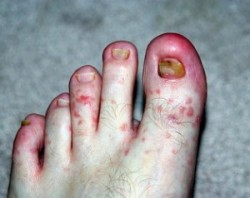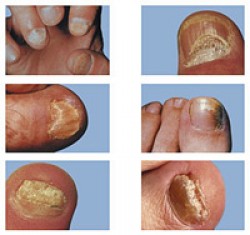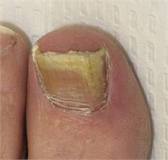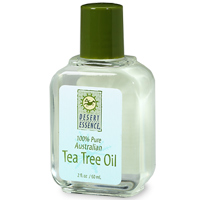Children and Nail Fungus Infections
Children and Nail Fungus Infections
 Although it is far less likely than not that a child will contract a nail fungus infection, it does happen. Onychomycosis, or nail fungus, is more commonly an adult disease, but as children spend a great deal of time getting into things they shouldn’t and playing in the dirt, they have as much potential as anyone else to attract the fungus that causes the infection.
Although it is far less likely than not that a child will contract a nail fungus infection, it does happen. Onychomycosis, or nail fungus, is more commonly an adult disease, but as children spend a great deal of time getting into things they shouldn’t and playing in the dirt, they have as much potential as anyone else to attract the fungus that causes the infection.
For kids, the infection is more of a social affliction than anything. Other children may see the infected nail and want to avoid the person with the nail fungus because they think they’ll get sick. This can be really rough on a child’s self esteem.
And as the nail fungus infection develops, the nail can become painful and even possibly fall off. So treating the infection, or better yet avoiding the infection entirely is the best solution.
The infection tends to show up as whitish or yellowish spots on the nail, then gradually grows to cover the nail surface entirely so that the nail is opaque. The nail will then become thicker and more brittle, possibly flaking or crumbling at the edges. Depending on the type of infection, the nail can disengage from the nail bed and fall off, which can be very painful.
How Can I Prevent My Child From Becoming Infected?
Start by teaching your children good hygiene. Make them wash their hands when they come inside after playing. This will quickly remove any spores they may have picked up outside. Get a soft nail-brush and show them how to scrub underneath their nails as well, as that can be a very common area that nail fungus attack.
Keep your children’s nails trimmed close to the tips of their fingers and toes, as the less exposed nail there is, the less surface is available to the spores to invade.
Put antifungal powder in their shoes overnight so they don’t risk infection from wearing shoes all the time. Wash their socks in bleach to kill off anything that might be lurking in the fibers.
If you do end up with a child contracting a fungal nail infection, simple methods of controlling the disease are:
• Rubbing Tea Tree Oil on the infected nail and surrounding skin
• Soaking the infected nail in a solution of vinegar and water twice a day
• Clean underneath the nails to remove the dirt and then wipe with rubbing alcohol to kill the fungus.
If these solutions don’t have an effect, you can speak with your child’s doctor about other available treatments. Some of these, particularly the oral antifungal medications, do carry the risk of liver damage, so be careful which option you choose, and make sure your child’s health is up to the treatment.
Easily Applied Home Nail Fungus Remedies
Easily Applied Home Nail Fungus Remedies
 Having unattractive toenails is embarrassing and even humiliating. There are many ways to solve this incredibly common problem.
Having unattractive toenails is embarrassing and even humiliating. There are many ways to solve this incredibly common problem.
How Does My Nail Become Infected?
Toenails come into contact with microorganisms that get onto the skin, the nail sheath and underneath the nail to the nail bed. Any and all of these places can easily become a hotbed (literally) for infection. Once you have contracted a fungal infection, it can be very difficult to cure.
As these microorganisms are fungal spores, they thrive in places that have no light and high humidity. This makes the feet very susceptible to infection because we are all accustomed to wearing shoes. Especially because many people wear the same pair of shoes day in and day out, not allowing time for them to dry and air between wearings.
Trimming your toenails too close to the skin can cause accidental cuts, providing another entry point for these fungal spores.
Shoes that fit to tightly can also be a cause of toenail fungus infection as they leave no room for your feet to breath and they can cause the breakdown of the nail where they rub, leaving an opening for the fungus to invade.
Standard Symptoms of Nail Fungus Infection
Here are some very simple ways to recognize a toenail fungus infection:
- A discoloration of the toenail, white to yellow
- The nail becomes thick and disfigured
- A stinging pain from under and around the nail
- Brown or black spots developing on the nail
- Parts of the nail crumble or flake off
- A foul odor coming from the nail
- Oozing pus from around the nail
- Toenail falling off entirely
Recommended Home Remedies for Fungal Nail Infection
The faster you catch a fungal nail infection, the easier it is to get rid of it. The early stages can be treated with any of the remedies listed below:
- ClearFungus – This is the leading natural remedy for curing toenail fungus. This is considered more of a natural product anti-fungal treatment than a home remedy as it is specially formulated to kill toenail fungus and promote new nail growth.
- Vicks VapoRub – Although no one quite understands why, Vicks VapoRub seems to prove very effective at stopping the growth of fungal infection. It does not kill the fungus but does inhibit growth, which can encourage healthy nail growth until the infection has been trimmed entirely away. No studies have been done on this but many people swear by it.
- Hydrogen Peroxide, Listerine and Rubbing Alcohol – Combined or separately, all of these chemicals have been shown to have some effect on nail fungus as they all posses antiseptic properties. Soak your toenails in your choice of these solutions (again, combined or separately) for twenty minutes, two times a day.
- Tea Tree Oil – This is a powerful essential oil that contains antiseptic and antifungal components. Wash and thoroughly dry the foot, then rub the affected nail(s) and surrounding skin with Tea Tree Oil twice a day.
- Vinegar – Soaking your toes in a solution of equal parts vinegar and water in a large tub or bowl for 20-30 minutes, then washing and thoroughly drying your feet until the infection has cleared.
These remedies are good for stopping the infection early on. If you follow these instructions closely and stick to the regular process, you should be able to clear up your infection by yourself. If your symptoms are bad to begin with, or if they worsen, seeking the help of a medical professional will become necessary.
A Doctor’s Detailed Description of Onychomycosis
A Doctor’s Detailed Description of Onychomycosis
 Onychomycosis is the medical term for a fungal infection of the fingernails or toenails. Onycho refers to the nail, mycosis refers to fungal infection. This condition represents about 33% of all fungal skin infections. Approximately half of all diagnosed diseases of the fingernails or toenails are onychomycosis.
Onychomycosis is the medical term for a fungal infection of the fingernails or toenails. Onycho refers to the nail, mycosis refers to fungal infection. This condition represents about 33% of all fungal skin infections. Approximately half of all diagnosed diseases of the fingernails or toenails are onychomycosis.
Onychomycosis usually occurs in older people, most commonly 40 and above. The likelihood of the disease occurring in adults rather than children is about 30%. Onychomycosis is a regularly occurring disease and the chances of contracting it increase as people age. Approximately 20% of all people between the ages of 40 and 60 have onychomycosis. It is thought that upwards of 90% of elderly patients have it.
Onychomycosis occurances
Onychomycosis occurs more regularly in men than in women, however women are more likely to contract a specific type of the fungus called Candida. The disease seems to have no preference in race. There has been an increase in the number of cases of onychomycosis in recent years. Doctors believe this has to do with people living longer, thus facing the greater probability of diseases that are common causes of onychomycosis. For instance, the level of diabetes has increased in the population as well. The same corollary can be drawn between the aging population and the number of people with diabetes. Interestingly enough, having diabetes makes it more likely that a patient will contract onychomycosis as diabetics have a harder time fighting off infection and healing from wounds. Poor circulation is another commonly related disease as people who suffer from this have a less healthy immune system.
The most common symptom and complaint of sufferers of onychomycosis is the disfiguration of the nail. One of the greatest difficulties in catching a fungal nail infection early on is that it doesn’t present serious symptoms, especially in the beginning, when it is easiest to cure.
The fact that onychomycosis disfigures the nail is not to be disregarded. It causes people to avoid certain social interactions because of the embarrassment they feel having a nail fungus will bring. They become concerned that a fungal infection is infectious or that they will be seen as “unclean” or “unhealthy”. It is of serious concern to doctors, the psychological and emotional effect that onychomycosis can have on people.
Although this disease starts as a series of cosmetic symptoms, if left unchecked it can develop into a far more serious set of problems. Pain in the affected finger or toe can occur. Because the nail thickens, it deadens the sensitivity in the affected digits. This can lead to loss of sensation and therefore ability in the hands and feet. Tasks like writing and other daily activities are affected by fingernail fungus, being able to sense the floor, causing difficulty with walking and even causing serious falls, are an advanced symptom of toenail fungus. For patients who are already affected by diseases that cause problems with the nerves in the legs, this can make things even worse.
There are four main types of onychomycosis:
- Distal subungual onychomycosis – This is the most common form of onychomycosis and is caused by a dermatophyte called Trichophyton rubrum. What happens is the dermatophyte penetrates the nail plate and buries itself in the nail bed. The term ‘subungual’ refers to underneath the nail. The infection manifests as a whitish-yellow growth under and on the nail towards the tip (the part you trim) This then works its way down toward the cuticule and underneath to the nail bed. The nail becomes thick, pitted, ridged and can start to crumble.
- Proximal subungual onychomycosis – starts at the cuticle end of the nail instead of at the tip. It then works its way up the nail and under the nail as the nail grows out. This form of nail fungus infection occurs more regularly in people who have issues with immune deficiency. Proximal subungual onychomycosis is caused by Trichophyton ruburm, just as distal subungual onychomycosis is, but it is also caused by other fungi and molds.
- White superficial onychomycosis – This is probably the least commonly occurring form of onychomycosis, happening in only 1 of 10 cases on average. This fungus develops on the top of the nail or in its topmost layers. As the name ‘white superficial’ would imply, this is a lesion that forms at the top of the nail and is white in color. Gradually, the fungus will take over the entire nail if left unchecked. Unlike most other forms of onychomycosis, white superficial onychomycosis is caused by Trichophyton mentagrophytes, a different dermatophyte.
- Candida onychomycosis – This final form of onychomycosis starts out its life as chronic mucocutaneous candidas, or reoccurring mucous level or low level yeast infection. This tends to affect the skin surrounding the nail, specifically in the proximal and lateral nail folds. Usually multiple nails are affected by Candida onychomycosis and the nails can be fully destroyed by this more serious form of fungal infection.
References
Hainer BL. Dermatophyte infections. Am Fam Physician 2003;67:101-108.
Jaffe R. Onychomycosis: recognition, diagnosis, and management. Arch Fam Med 1998;7:587-592.
Kaur R, Kashyap B, Bhalla P. Onychomycosis–epidemiology, diagnosis and management. Indian J Med Microbiol 2008;26:108-116.
So How Do I Tell if My Toenail is Infected With a Fungus?
So How Do I Tell if My Toenail
is Infected With a Fungus?
 Having a nail that is infected with a fungus is not all that uncommon as it affects 10-12% of the American population. A toenail fungal infection is caused by microorganisms that lodge in the tiny cracks in the skin around the toenails. As the foot usually lives in a dark, damp environment, this is an ideal growing medium for the fungal spores. The symptoms of a fungal toenail infection are fairly consistent and if you know what to look for it is easier to catch it early on.
Having a nail that is infected with a fungus is not all that uncommon as it affects 10-12% of the American population. A toenail fungal infection is caused by microorganisms that lodge in the tiny cracks in the skin around the toenails. As the foot usually lives in a dark, damp environment, this is an ideal growing medium for the fungal spores. The symptoms of a fungal toenail infection are fairly consistent and if you know what to look for it is easier to catch it early on.
The first symptom to show up is usually a white or yellowish spot on the toenail. This may be a minute object, which makes it harder to recognize. This spot is the beginnings of the infection and will gradually grow to cover more of the nail. As most people don’t suffer any discomfort and with the advent of wearing nail polish, many people don’t even notice this minor change.
As the infection continues, the small spot will increase and cover the entire toenail. The toenail will become dull, yellowed and even change shape. Some people see a dark spot either where the infection began or around the edges of the toenail, though this happens more frequently with severe cases. At some point, the nail may become disconnected from the nail bed.
Nail becoming yellow and thick?
The process of the nail becoming yellow and thick is a classic toenail fungus symptom. Also common is flaking or crumbling of the toenail, which again occurs in the severe cases of the disease.
The only way to determine whether your symptoms are that of a toenail fungal infection or are the result of something that mimics these symptoms is to see your doctor. At that point your doctor will be able to ask you some questions and take a sample of your toenail to be examined under a microscope and/or cultured. Be sure to tell your doctor if you have spent time in a public pool or spa lately as this may increase your chances of contracting a toenail fungus infection.
Ask the doctor
Once your doctor has been given the chance to examine and sample your toenail, a solution will be able to be found that will be most effective for you. This will help your doctor determine which medication will be best for your particular infection. Toenail funguses are notoriously difficult to treat and cure, so allowing your doctor to get all the pertinent information will help you both to make an informed decision. One of the problems with nail funguses is that they all tend to display the same symptoms but that doesn’t mean they require the same treatment. And there are other conditions that will mimic the standard symptoms of a nail fungus, so working with your doctor to come up with the best treatment is in everybody’s interest.
Curing Toenail Fungus with Tea Tree Oil
Curing Toenail Fungus with Tea Tree Oil
 It is very uncommon for a doctor to recommend an alternative remedy over a prescription medicine. However in the case of Tea Tree Oil, this happens more often than not. Tea Tree Oil is a naturally occurring medicine and has been shown to be effective at eliminating the fungus that causes toenail infections. The Mayo Clinic has even run studies to confirm this. So why is this oil so effective? Because of its own natural physical properties.
It is very uncommon for a doctor to recommend an alternative remedy over a prescription medicine. However in the case of Tea Tree Oil, this happens more often than not. Tea Tree Oil is a naturally occurring medicine and has been shown to be effective at eliminating the fungus that causes toenail infections. The Mayo Clinic has even run studies to confirm this. So why is this oil so effective? Because of its own natural physical properties.
This plant is native to Australia and has been used for centuries by the aboriginal people for curing and preventing infections. The plant acts as an antimicrobial and while the medical community sees much potential in the Tea Tree, the majority of studies have centered around Tea Tree Oil being used as an antifungal. The treatment of a fungal infection takes a long time and it is not uncommon for someone participating in a study to give up and drop out part way through. Even one person doing this can throw off the results of a study, leaving it with the result of “null and void” or “unclear”.
Tea Tree Oil Popularity
No matter that the Mayo Clinic has run studies on this product, the general public has taken to Tea Tree Oil like a duck to water. If you run a search on Tea Tree Oil, you will find not only a wide variety of products and distributors, but also people singing its praises, telling how it helped them treat their toenail fungus infections. This information can be found both as testimonials on distributor websites but also as entries and responses on forums. This is real data submitted by real people, saying how happy they are that they were able to find a natural remedy to cure their nail fungus infection completely and inexpensively. As with all medications, both prescription and alternative, the results will vary from person to person and how long it takes or if it is effective will depend on the severity of the infection.
It is recommended that the strength of the Tea Tree Oil is 100% and that it is applied to the surface of the infected nail and surrounding tissue to ensure that all hiding places for the fungus are covered. If you plan on a Tea Tree Oil regimen, it is recommended to purchase some soap or shampoo that contains Tea Tree Oil and use it to wash your feet several times a day. Once your feet are clean, dry them thoroughly and then apply the Tea Tree Oil directly to the affected areas. Mind the amount you use as too much can cause irritation.
Please note: Tea Tree Oil is a topical treatment only and should never be ingested as it can cause a severe toxic reaction! As with any medication, if you experience an allergic reaction, discontinue use immediately, wash the affected areas with soap that doesn’t contain tea tree oil and contact your doctor. This may be an herbal remedy, but your doctor should still be informed that you are using it and how you are progressing because it is still a medication, even if it is a natural one. This is even more important if you have any sort of skin condition, such as eczema. Remember that fungus like dark, damp environments and the more you can do to discourage a place for them to develop, the less likely it will be that you will contract an infection.